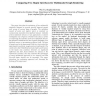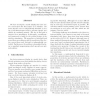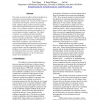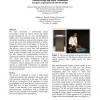HAPTICS
2002
IEEE
15 years 5 months ago
2002
IEEE
The range of human kinematic motion as well as force resolution should be known for design of a haptic device. In addition, a haptic interface can be designed more easily when mas...
87
Voted
HAPTICS
2002
IEEE
15 years 5 months ago
2002
IEEE
This paper describes the evaluation of two multimodal interfaces designed to provide visually impaired people with access to various types of graphs. The interfaces consist of aud...
102
Voted
HAPTICS
2002
IEEE
15 years 5 months ago
2002
IEEE
: We present a six-degree-of-freedom haptic rendering algorithm using localized contact computations. It takes advantage of high motion coherence due to fast force update and spati...
104
click to vote
HAPTICS
2002
IEEE
15 years 5 months ago
2002
IEEE
In this paper, we present computationally efficient algorithms for the real time simulation of minimally invasive surgical (MIS) procedures. To develop a surgical simulator for tr...
95
Voted
HAPTICS
2002
IEEE
15 years 5 months ago
2002
IEEE
This paper investigates the problem of perceived instability during haptic texture rendering. We focus on the perceptual analysis of the stability of textured surfaces rendered wi...
HAPTICS
2002
IEEE
15 years 5 months ago
2002
IEEE
We have developed a tactile display that uses electric current from the skin surface as a stimulus. Our main objective was to independently stimulate a variety of mechanoreceptors...
95
Voted
HAPTICS
2002
IEEE
15 years 5 months ago
2002
IEEE
The Rutgers Master II-ND glove is a follow up on the earlier Rutgers Master II haptic interface. The redesigned glove has all the sensing placed on palm support, avoiding routing ...
137
Voted
HAPTICS
2002
IEEE
15 years 5 months ago
2002
IEEE
We present the results of using Hidden Markov Models (HMMs) for automatic segmentation and recognition of user motions. Previous work on recognition of user intent with man/machin...
103
Voted
HAPTICS
2002
IEEE
15 years 5 months ago
2002
IEEE
This study explores the effects of haptic feedback on performance and learning by human subjects executing a dynamic task. We present the results of experiments involving the cont...
104
click to vote
HAPTICS
2002
IEEE
15 years 5 months ago
2002
IEEE
We have developed a multi-modal virtual environment set-up by fusing visual and haptic images through the use of a new autostereoscopic display and a force-feedback haptic device....




